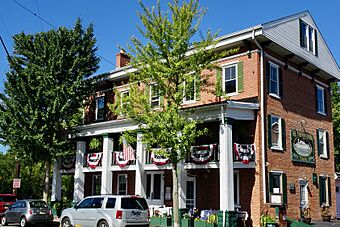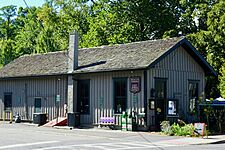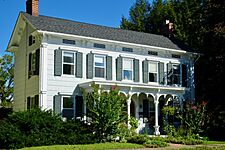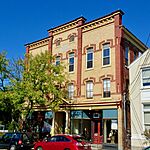Frenchtown, New Jersey facts for kids
Quick facts for kids
Frenchtown, New Jersey
|
||
|---|---|---|
|
Borough
|
||
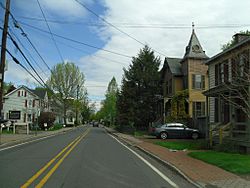
Harrison Street in Frenchtown
|
||
|
||

Location of Frenchtown in Hunterdon County highlighted in red (left). Inset map: Location of Hunterdon County in New Jersey highlighted in orange (right).
|
||

Census Bureau map of Frenchtown, New Jersey
|
||
| Country | ||
| State | ||
| County | ||
| Incorporated | April 4, 1867 | |
| Government | ||
| • Type | Borough | |
| • Body | Borough Council | |
| Area | ||
| • Total | 1.23 sq mi (3.18 km2) | |
| • Land | 1.13 sq mi (2.92 km2) | |
| • Water | 0.10 sq mi (0.26 km2) 8.05% | |
| Area rank | 481st of 565 in state 20th of 26 in county |
|
| Elevation | 220 ft (70 m) | |
| Population
(2020)
|
||
| • Total | 1,370 | |
| • Estimate
(2023)
|
1,472 | |
| • Rank | 519th of 565 in state 22nd of 26 in county |
|
| • Density | 1,214.2/sq mi (468.8/km2) | |
| • Density rank | 359th of 565 in state 6th of 26 in county |
|
| Time zone | UTC−05:00 (Eastern (EST)) | |
| • Summer (DST) | UTC−04:00 (Eastern (EDT)) | |
| ZIP Code |
08825
|
|
| Area code(s) | 908 | |
| FIPS code | 3401925350 | |
| GNIS feature ID | 0885227 | |
| Website | ||
Frenchtown is a borough in Hunterdon County, in the U.S. state of New Jersey. Frenchtown is located along the banks of the Delaware River on the Hunterdon Plateau, 32 miles (51 km) northwest of the state capital of Trenton. As of the 2020 United States census, the borough's population was 1,370, a decrease of three people (−0.2%) from the 2010 census count of 1,373, which in turn reflected a decline of 115 (−7.7%) from the 1,488 counted in the 2000 census.
Contents
History
Naming Frenchtown
Various names have been applied to this settlement after the many ferry operators residing on both sides of the river. The community had variously been known as Alexandriaville, Sunbeam and Frenchtown over the years. The borough was formed by an Incorporation act of the New Jersey Legislature on April 4, 1867, from portions of Alexandria Township. Additional territory was acquired from Kingwood Township in 1876.
Bridges
The first bridge across the Delaware at Frenchtown was a six-span covered wooden bridge built in 1841 on the five piers that still stand today, and the community became a gateway to Pennsylvania. The present day steel truss Uhlerstown-Frenchtown Bridge is a free Delaware River Joint Toll Bridge Commission bridge over the Delaware River connecting Frenchtown to Uhlerstown, Bucks County, Pennsylvania.
Lenape and early European settlers
The Lenape Native Americans had populated the area until they were fully supplanted by European settlement around 1750. About 1725, a group of French Huguenot refugees settled in Hunterdon County. Originally from the Picardy region of France, they had fled after the revocation of the Edict of Nantes in 1685 when the King began persecution of non Catholics in France. One notable settler was Luther Calvin, a landowner and ferry operator who also bought a Hotel on Everittstown Road. Calvin also served as a 1st Lieutenant of the Associated Companies in 1756 during the French and Indian War. In 1757, three joint owners of a tract purchased from the West Jersey Land Society began laying out streets and building lots at what was then known as Calvin's Ferry. The developing town was to be called "Alexandria" in honor of William Alexander, Lord Stirling, one of the three owners. In 1776, the three sold the settlement to Thomas Lowrey, a Flemington speculator. In 1794, Lowrey sold the tract to Paul Henri Mallet-Prevost, a Swiss fugitive from the French Revolution. He and other early settlers were French speaking, leading some to begin calling the settlement "Frenchtown."
The canal, railroad, and industry
Lambertville grew substantially in the next four decades. A trade in grain and other farm products brought into town developed. Boatmen and river men helped fuel Frenchtown's growth through their buying of cargo and food, and hiring of pilots. In the years after Henri Mallet-Prevost's death, his sons sold off portions of their property and no longer was the town privately owned.
The arrival of the Belvidere Delaware Railroad in 1853 sparked continued growth in Frenchtown. Steam-powered industry became widely developed, and by the 1860s, water powered mills were being converted into larger factories. Around the same time, the town had three major hotels: The Lower Hotel (Present day Frenchtown Inn), The Middle Hotel (no longer existing), and the Upper Hotel (The National Hotel). In 1889, Britton Brothers Big Brick Store, which sold a variety of goods, opened on Bridge Street. The railroad eventually became a branch of the Pennsylvania Railroad. It no longer operates but its tracks are still evident. The Delaware and Raritan Canal had been constructed adjacent to the Delaware River in the 1800s. It was quickly abandoned upon the arrival of the paralleling railroad. Its extant towpaths are now a popular biking and hiking trail from Trenton through Lambertville to Frenchtown and beyond. It is maintained by the State of New Jersey as the Delaware and Raritan State Park Trail.
In the early 20th century, growth was spurred by the arrival of Frenchtown Porcelain Works, the establishment of the Milford plant of the Warren Paper Company, and the rise of the poultry industry.
Floods
Hurricane Diane in 1955 raised the level of the Delaware River dramatically and flooded the streets of Frenchtown as well as other riverbank towns and caused serious damage to buildings and residences. Frenchtown streets have flooded on occasion due to other hurricanes since 1955.
Geography
According to the United States Census Bureau, the borough had a total area of 1.23 square miles (3.18 km2), including 1.13 square miles (2.92 km2) of land and 0.10 square miles (0.26 km2) of water (8.05%).
Frenchtown borders the municipalities of Alexandria Township and Kingwood Township in Hunterdon County; and Tinicum Township in Bucks County, across the Delaware River in the Commonwealth of Pennsylvania.
Frenchtown Solar is a group of three photovoltaic arrays forming one of the largest solar farms in the state covering 110 acres (44.5 ha) with 68,500 solar panels and 20.1 megawatt capacity.
Demographics
| Historical population | |||
|---|---|---|---|
| Census | Pop. | %± | |
| 1870 | 912 | — | |
| 1880 | 1,039 | 13.9% | |
| 1890 | 1,023 | −1.5% | |
| 1900 | 1,029 | 0.6% | |
| 1910 | 984 | −4.4% | |
| 1920 | 1,104 | 12.2% | |
| 1930 | 1,189 | 7.7% | |
| 1940 | 1,238 | 4.1% | |
| 1950 | 1,305 | 5.4% | |
| 1960 | 1,340 | 2.7% | |
| 1970 | 1,459 | 8.9% | |
| 1980 | 1,573 | 7.8% | |
| 1990 | 1,528 | −2.9% | |
| 2000 | 1,488 | −2.6% | |
| 2010 | 1,373 | −7.7% | |
| 2020 | 1,370 | −0.2% | |
| 2023 (est.) | 1,472 | 7.2% | |
| Population sources: 1880–1920 1880–1890 1890–1910 1910–1930 1940–2000 2000 2010 2020 |
|||
2010 census
The 2010 United States census counted 1,373 people, 596 households, and 366 families in the borough. The population density was 1,087.2 inhabitants per square mile (419.8/km2). There were 656 housing units at an average density of 519.4 per square mile (200.5/km2). The racial makeup was 96.65% (1,327) White, 0.80% (11) Black or African American, 0.36% (5) Native American, 0.95% (13) Asian, 0.00% (0) Pacific Islander, 0.07% (1) from other races, and 1.17% (16) from two or more races. Hispanic or Latino of any race were 5.10% (70) of the population.
Of the 596 households, 26.7% had children under the age of 18; 46.0% were married couples living together; 11.1% had a female householder with no husband present and 38.6% were non-families. Of all households, 31.4% were made up of individuals and 8.7% had someone living alone who was 65 years of age or older. The average household size was 2.27 and the average family size was 2.88.
20.9% of the population were under the age of 18, 6.2% from 18 to 24, 27.3% from 25 to 44, 34.3% from 45 to 64, and 11.3% who were 65 years of age or older. The median age was 42.6 years. For every 100 females, the population had 95.6 males. For every 100 females ages 18 and older there were 95.3 males.
The Census Bureau's 2006–2010 American Community Survey showed that (in 2010 inflation-adjusted dollars) median household income was $62,574 (with a margin of error of +/− $9,339) and the median family income was $76,250 (+/− $12,807). Males had a median income of $62,500 (+/− $7,602) versus $34,886 (+/− $5,656) for females. The per capita income for the borough was $33,966 (+/− $5,364). About 4.9% of families and 8.0% of the population were below the poverty line, including 11.1% of those under age 18 and 4.3% of those age 65 or over.
Historic district
The Frenchtown Historic District is a 100-acre (40 ha) historic district encompassing the community. It was added to the National Register of Historic Places on May 19, 1994, for its significance in architecture, commerce, community planning and development, and transportation from 1795 to 1931. The district includes 401 contributing buildings, one contributing structure, and one contributing site. It includes the Uhlerstown–Frenchtown Bridge, which crosses the Delaware River.
The Frenchtown Inn was built in 1832 and features Greek Revival architecture. The Frenchtown Station for the Belvidere Delaware Railroad was built c. 1853 and is now the Bridge Cafe. The Nathaniel Shurtz house was built c. 1865 with Italianate style. The Oddfellows Building was built in 1879 with Romanesque Revival architecture.
Education
The Frenchtown School District serves public school students in pre-kindergarten through eighth grade at Edith Ort Thomas Elementary School. As of the 2022–23 school year, the district, comprised of one school, had an enrollment of 105 students and 14.6 classroom teachers (on an FTE basis), for a student–teacher ratio of 7.2:1. In the 2016–2017 school year, Frenchtown was tied for the 18th-smallest enrollment of any school district in the state, with 129 students.
Public school students in ninth through twelfth grades attend the Delaware Valley Regional High School in Frenchtown, which serves students in western Hunterdon County from Alexandria, Holland and Kingwood townships along with the boroughs of Frenchtown and Milford. As of the 2022–23 school year, the high school had an enrollment of 722 students and 59.9 classroom teachers (on an FTE basis), for a student–teacher ratio of 12.1:1. The nine seats on the high school district's nine-member board of education are allocated based on population, with one seat allocated to Frenchtown.
Eighth grade students from all of Hunterdon County are eligible to apply to attend the high school programs offered by the Hunterdon County Vocational School District, a county-wide vocational school district that offers career and technical education at its campuses in Raritan Township and at programs sited at local high schools, with no tuition charged to students for attendance.
Transportation
As of May 2010[update], the borough had a total of 10.32 miles (16.61 km) of roadways, of which 7.50 miles (12.07 km) were maintained by the municipality, 2.36 miles (3.80 km) by Hunterdon County and 0.34 miles (0.55 km) by the New Jersey Department of Transportation and 0.12 miles (0.19 km) by the Delaware River Joint Toll Bridge Commission.
The borough is traversed by several roadways. Frenchtown is the northern terminus of Route 29, the western terminus of Route 12 and the southern terminus of Route 513.
The Uhlerstown–Frenchtown Bridge is a toll-free bridge over the Delaware River, owned and operated by the Delaware River Joint Toll Bridge Commission, connecting New Jersey Route 12 in Frenchtown with Pennsylvania Route 32 in Uhlerstown, located in Tinicum Township, Bucks County, Pennsylvania. Reconstructed in 1931, the bridge is a six-span Warren truss that extends 950 feet (290 m).
Civic events
Frenchtown holds La Fete Nationale on Bastille Day in July with a different theme each year related to borough's "French heritage and flavor".
Notable people
People who were born in, residents of, or otherwise closely associated with Frenchtown include:
- James Agee (1909–1955), author, editor and poet who lived in Frenchtown (on Second Street in what is now the police station) with second wife Alma from 1938 to 1939 and wrote Let Us Now Praise Famous Men during that time
- Elizabeth Gilbert (born 1969), author of Eat, Pray, Love
- Shea Hembrey (born 1974), conceptual artist
- Lois Hunt (1925–2009), soprano opera singer who toured for decades with baritone Earl Wrightson
- Anne Kursinski (born 1959), top show jumping competitor
- Harvey Spencer Lewis (1883–1939), Rosicrucian author, occultist and mystic
- J. Linus McAtee (1897–1963), thoroughbred horse racing jockey
- Barb Morrison (born 1967), songwriter and record producer
- Billy Pauch (born 1957), race car driver
- Anna Pump (1934–2015), chef, cookbook author, baker, and innkeeper famous for her bakery in The Hamptons, Loaves & Fishes
- Nathanael West (1903–1940), novelist, screenwriter and satirist, author of Miss Lonelyhearts and The Day of the Locust, boarded at the Frenchtown Inn during the 1930s
See also
 In Spanish: Frenchtown para niños
In Spanish: Frenchtown para niños





